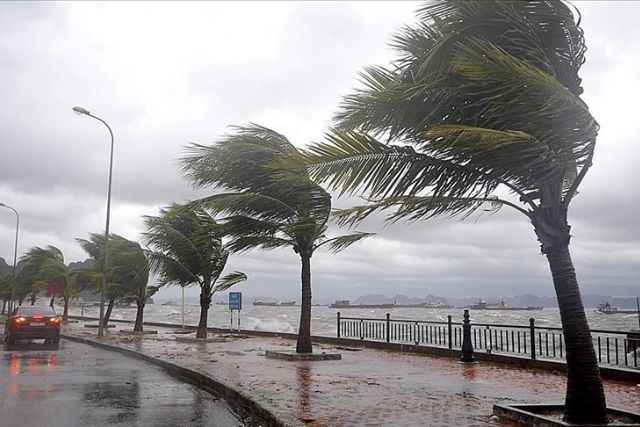Severe drought leaves Kenyans hungry, fuels conflict with wildlife
Drought has caused increased cases of human-wildlife conflict as people, animals often go for days without single drop of water

GARISSA, Kenya
After many months without rain due to a change in climate conditions, many communities in northern Kenya are facing a harsh life coupled with life-threatening hunger and competition with wild animals for resources such as water and pastures.
Kenya has declared the drought that has ravaged 10 out of its 47 counties a national disaster.
The National Treasury and the Ministry of Interior and Coordination of National Government has moved in to assist affected households with water and relief food distribution as well as livestock uptake, but the help will be gradual, and at present, many are still suffering.
In Garissa County in northeastern Kenya, Omar Abdul, a local resident, keeps cows and goats as his main source of livelihood.
Around his homestead, trees that were used to be green have turned yellow, vegetation around the area looks wilted and deprived of water for a long period, and grass which normally bends to a degree when stepped on due to its fleshy stems now makes a cracking sound like what you would expect when breaking a stick.
Garissa County is among the 10 counties in Kenya affected by the severe drought, and for many people, the drought has affected education in pastoral and nomadic communities, caused displacement, and above all has left many facing hunger to the point of starvation.

Livestock, wildlife dying due to unrelenting drought
Abdul laments that the drought has been severe and relentless.
“So many people have lost their animals. Thousands of animals have died. If you walk around with me, I can show you where cows and goats lie dying or dead. There is no water for me and my family. Where am I to get water for my livestock? Out of almost 60 goats, I have only 30 which are just hanging on to dear life,” he said.
Abdul pointed in the distance to what seemed like the horizon.
“I will take you there if you want. The water points are dry. People come from far to try and get water for their already tired animals, but they find no water and no pasture. The animals cannot make it back alive. There are rotten carcasses everywhere. The ground is too dry and sunbaked to even bury them. There are wild animals that have died also all over.”
Around the area, dead animals, including cows, goats, and others, could be seen. Wild animals such as giraffes also lay dead due to biting hunger from the loss of vegetation and the drought.
Another local, Abishar Abdi, said wild animals come in search of water and food in populated areas.
“The animals come to where we live in search of water and any food they might get. This is a brewing conflict between animals and humans. To them, a goat is food, same to a cow. This is why there are many cases of animals attacking humans,” Abdi said.
'Human-wildlife conflict inevitable'
He added that the quest for lifesaving nutrition works both ways and gave a reason why human-wildlife conflict is inevitable.
“Look at the cracks on the ground and how dry this area is. That is the color of death. We have to travel far and sometimes to protected wildlife areas in search of vegetation. There will be a conflict there with animals, right?” Abdi said, adding that “even conflict among communities arises in such situations over grazing lands.”
Cases of human-wildlife conflict in northern Kenya and other areas affected by the drought, which has left over 2 million people facing starvation, have increased immensely.
On Sept. 9, a herder was mauled and killed by a lion in Laikipia, Kenya, the attack just coming weeks after lions attacked and killed cows in the same region.
Across the country, cases of lions killing livestock have also been on the rise, a new phenomenon that is not common.
“We cannot raise money to take our children to school. Even the schools have no water. Our livestock is very weak. Even farmers who depend on the Tana River are suffering as their crops are dying. There is so much loss, especially because of the costs incurred when tilling the land, fertilizers, and other things,” Dalila Habiba, a mother of three, lamented.
Livestock business crippled
Abdul Bahari, the chief administrative secretary of the Devolution and Arid and Semi-arid Lands Ministry, said he has toured most of the northeastern counties in Kenya.
“The drought now is at its height. The water crisis is with us. The livestock has lost weight. The livestock markets are now at their lowest (level of production)," Bahari said, referring to the livestock market business, the area's main economic activity that has been interrupted.
"The schools have reopened. Parents need (to pay) school fees and are not able to meet that because the livestock market is not active now. They are burdened with the problems of water.”
He said the government is putting together resources to alleviate the effects of the drought.
According to the records of Kenya's National Drought Management Authority, at least 2 million Kenyans have been hit hard by the current drought, with predictions that the dry spell will worsen in the coming months.
Devolution and Arid and Semi-Arid Lands Minister Eugene Wamalwa said recently that the government will provide water and cash transfer aid for households that have been affected.





